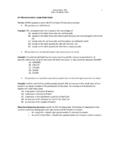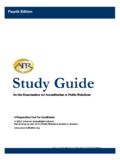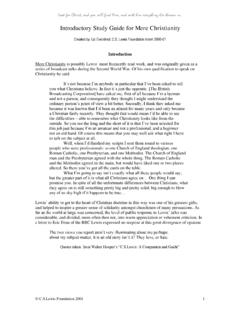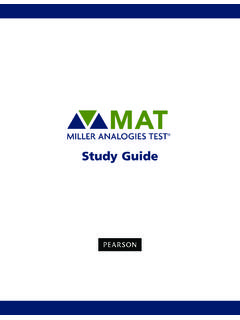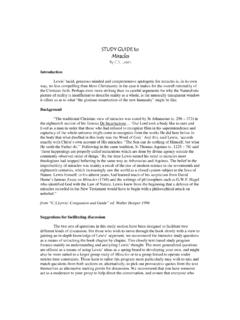Transcription of AP Microeconomics: Exam Study Guide Format: …
1 Jason Welker 2009 1. Zurich International School ap microeconomics : Exam Study Guide Format: 60 MC questions worth of total. 70 minutes to answer 20 questions are definitional Example: The unemployment rate measures the percentage of (A) people in the labor force who do not have jobs (B) people in the labor force who have a part-time job but are looking for a full-time job (C) people who do not have jobs and have given up looking for work (D) people in the adult population who do not have jobs (E) people in the adult population who have temporary jobs 20 questions are analytical (require two step process to solve). Example: If a commercial bank has no excess reserves and the reserve requirement is 10. percent, what is the value of new loans this bank can issue if a new customer deposits $10,000? (A) $100,000. (B) $90,333. (C) $10,000. (D) $9,000. (E) $1,000. 20 questions are synthesis questions (require two or three thought processes to solve).
2 Example: Leather and beef are jointly produced such that an increase in the production of one results in an equal increase in the production of the other. An increase in the demand for leather will most likely cause (A) a decrease in the price of leather (B) a decrease in the price of beef (C) a decrease in the equilibrium quantity of beef sold (D) an increase in the demand for beef in the short run (E) an increase in the supply of leather Three Free Response Questions worth of total grade. 10 minutes of preparation time (used to sketch possible graphs and take notes) and 50 minutes to answer. o #1: Long FRQ should take approximately 25 minutes to answer o #2 and 3: Short FRQs should take approximately minutes each to answer. Jason Welker 2009 2. Zurich International School Circular Flow Diagram: This is so crucial to understand for both Micro and Macro! Study the flow of income in the resource and product markets, and pay attention to the role of government in the economy.
3 Product C, I, G, Xn Market (Expenditures). Goods and services Taxes Taxes Households Government Firms Transfer Transfer payments payments Labor, land, capital, entrepreneurship Factor Wages, rent, interest, Market profit (Incomes). Implications of Circular Flow diagram: W + R + I + P = C + I + G + Xn MICRO Concept Review: Definitions Supply: A schedule or curve showing the possible combinations of price and quantity supplied. Law of Supply: There is a direct relationship between price and quantity supplied. Demand: A schedule or curve showing the possible combinations of price and quantity demanded. Law of Demand: There is an indirect relationship between price and quantity demanded Reasons for the law of Demand (why the D curve slopes downward): Income effect: As price of a good decreases, consumers income appears to increase, so consumers demand a greater quantity of a good as the price goes down.
4 Substitution effect: As the price of one good decreases, other goods appear to become more expensive, so consumers demand a greater quantity of the good whose price has decreased. Diminishing marginal Utility: The more one consumes of a good, the less additional utility that last unit consumed provides, therefore consumers are only willing to buy additional units of a good if the price decreases. Normal goods: Goods for which Demand increases as consumer income increases (sometimes called superior goods). Jason Welker 2009 3. Zurich International School Inferior goods: Goods for which Demand decreases as consumer income increases. (examples may include fast food, cheap clothes, etc ). Determinants of Demand: A change in any of the following will result in a shift of the demand curve, meaning that at each possible price, a different quantity will be demanded. T consumers' tastes and preferences O other related goods' prices (compliments and substitutes).
5 E expectations of future prices I consumers' income S size of the market (number of consumers). S special circumstances (tsunami, war, etc ). Determinants of Supply: A change in any of the following will result in a shift of the supply curve, meaning that at each possible price a different quantity will be supplied. S subsidies (shift supply out) and taxes (shift supply in). T technology O other related goods prices (substitutes in production, basketballs and soccer balls). R resource costs (land, labor, capital, entrepreneurship). E expectations (of future prices). S size of the market (number of producers). Elasticity: measures the responsiveness of one variable to a change in another. Price elasticity of Demand: d Price elasticity of Supply: s Cross elasticity of Demand: xy d = % Qd xy = % Qd of good X. % P. % P of good Y. >1 - elastic s = % Qs <1 - inelastic % P. =1 unit elastic Determinants of price elasticity of demand: S substitutes P proportion of income L luxury or necessity A addictive or habit forming T time Jason Welker 2009 4.
6 Zurich International School Determinants of price elasticity of supply: Only TIME. As time goes by, firms are more responsive to changes in price. In the market period firms are unable to respond to price changes. In the short-run firms can intensify production using existing plants, therefore supply is more elastic. In the long-run firms can expand or reduce plant capacity, therefore supply is highly price elastic. Total Revenue Test: If P and TR => inelastic D. If P and TR => inelastic D. If P and TR => elastic D. If P and TR => elastic D. Rule of thumb: Price-elasticity of Demand tends to be higher for higher priced (luxury) goods since they make up a larger proportion of income. Price-elasticity of D tends to be lower for lower priced goods since they make up a smaller proportion of income. The Utility Maximization Rule: The consumer should allocate his/her resources (money income) so that the last dollar spent on each product yields the same amount of extra, marginal utility.
7 Rule: MU of product A = MU of product B = MU of product C, D, E, etc . P of A P of B P of C, D, E, etc . Tax Incidence and Deadweight Loss S1. Price S. Producers'. tax burden Pb Pe DWL. Ps Consumers'. tax burden D. Qt Qe Quantity Jason Welker 2009 5. Zurich International School Pe = Price at equilibrium, pre-tax Qe = Quantity demanded and supplied before tax Pb = Price buyers had to pay after the tax Px = Price sellers received after the tax Qt = Quantity demanded and supplied after the tax Blue box = Amount of tax born by the consumers in the form of lost consumer surplus Yellow box = Amount of tax born by producers in the form of lost producer surplus. Combined area of Blue and Yellow boxes = Tax Revenue Green box = DWL is the total efficiency loss that results from an under or over-allocation of resources towards the production of a good or service Why would the government impose a tax on a good such as above?
8 Doesn't it only lead to a disequilibrium and thus an under-allocation of resources towards the goods production? Yes, but what if this good creates negative externalities? What if S1 is closer to the MSC (Marginal Social Cost) curve whereas S is the MPC (Marginal Private Cost) curve? In these cases, a tax may be used to correct a market failure (such as second hand smoke or air pollution). Excise taxes like this also may be levied on goods simply to raise revenue to fund government spending (such as a new light rail system or other public or quasi-public goods). Tax incidence and elasticity: Remember, if Demand is highly inelastic then consumers will bear the brunt of the tax burden ( cigarettes and gasoline). If Demand is highly elastic then producers will bear the brunt of the tax burden. Be able to graph and explain tax burden with different Demand and Supply price-elasticities.
9 Costs of Production: You must understand the difference between explicit and implicit costs. Implicit: the opportunity cost of employing self-owned resources toward one activity rather than another (includes NORMAL PROFIT). Explicit: the money costs of employing resources owned by others, in the form of wages, rent and interest. Costs MC. ATC. AVC. AFC. Quantity Jason Welker 2009 6. Zurich International School Other things to remember about costs: Total cost (TC) = Fixed costs (FC) + Variable costs (VC). ATC = AFC + AVC. The distance between ATC and AVC represents AFC (which always declines as output increases b/c costs are spread out ). AVC is significant for firms to consider, b/c if price ever falls below AVC, the firms best option is to shut down, since it is no longer covering its fixed costs. It would minimize losses by shutting down! Again, notice that MC intersects both ATC and AVC at their lowest points; KNOW WHY!
10 Understand how the law of diminishing returns influences the shapes of these curves. What can cause cost curves to shift? A change in any variable cost (wages to workers, rent on land, interest on loans, etc ) will shift the MC, AVC and ATC curves. Also, an improvement in technology or productivity can cause the curves to shift DOWN. Why is the MC curve an individual firm's supply curve above the AVC? Keep this in mind. A firm will respond to price increases by increasing output as long as price is above AVC (remember the shutdown rule mentioned above). If a firm faces lower costs (wages, rents, interest) then its MC will shift down;. this translates to an outward shift of the individual firm's supply curve, meaning that at each price, the firm is willing to supply more output!! Perfect Competition: YOU MUST KNOW EVERYTHING ABOUT PC . Be able to draw a PC market with a representative firm.
